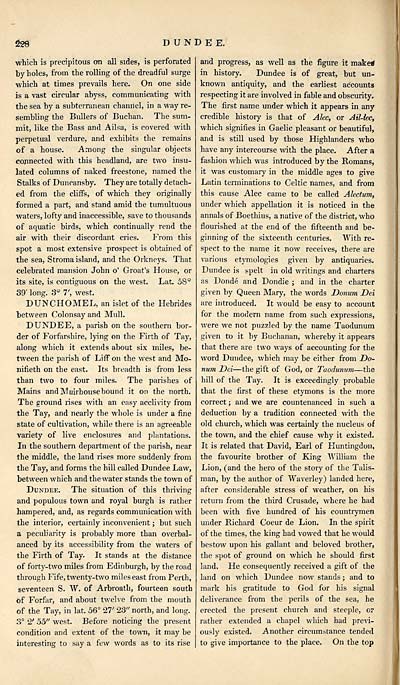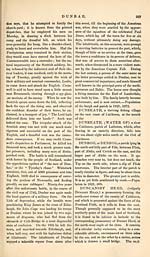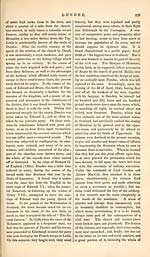Gazetteer of Scotland > Volume 1
(258) Page 228
Download files
Complete book:
Individual page:
Thumbnail gallery: Grid view | List view

228
DUNDEE.
which is precipitous on all sides, is perforated
by holes, from the rolling of the dreadful surge
which at times prevails here. On one side
is a vast circular abyss, communicating with
the sea by a subterranean channel, in a way re-
sembling the Bullers of Buchan. The sum-
mit, like the Bass and Ailsa, is covered with
perpetual verdure, and exhibits the remains
of a house. Among the singular objects
connected with this headland, are two insu-
lated columns of naked freestone, named the
Stalks of Duneansby. They are totally detach-
ed from the cliffs, of which they originally
formed a part, and stand amid the tumultuous
waters, lofty and inaccessible, save to thousands
of aquatic birds, which continually rend the
air with their discordant cries. From this
spot a most extensive prospect is obtained of
the sea, Stroma island, and the Orkneys. That
celebrated mansion John o' Groat's House, or
its site, is contiguous on the west. Lat, 58°
39' long. 3° 7', west.
DUNCHOMEL, an islet of the Hebrides
between Colonsay and Mull.
DUNDEE, a parish on the southern bor-
der of Forfarshire, lying on the Firth of Tay,
along which it extends about six miles, be-
tween the parish of Liff on the west and Mo-
nifieth on the east. Its breadth is from less
than two to four miles. The parishes of
Mains and Muirhouse bound it on the north.
The ground rises with an easy acclivity from
the Tay, and nearly the whole is under a fine
state of cultivation, while there is an agreeable
variety of live enclosures and plantations.
In the southern department of the parish, near
the middle, the land rises more suddenly from
the Tay, and forms the hill called Dundee Law,
between which and the water stands the town of
Dundee. The situation of this thriving
and populous town and royal burgh is rather
hampered, and, as regards communication with
the interior, certainly inconvenient ; but such
a pecubarity is probably more than overbal-
anced by its accessibility from the waters of
the Firth of Tay. It stands at the distance
of forty-two miles from Edinburgh, by the road
through Fife, twenty-two miles east from Perth,
seventeen S. W. of Arbroath, fourteen south
of Forfar, and about twelve from the mouth
of the Tay, in lat. 56° 27' 23" north, and long.
3° 2' 55" west. Before noticing the present
condition and extent of the town, it may be
interesting to say a few words as to its rise
and progress, as well as the figure it make*
in history. Dundee is of great, but un-
known antiquity, and the earliest accounts
respecting it are involved in fable and obscurity.
The first name under which it appears in any
credible history is that of Alec, or Ail-lee,
which signifies in Gaelic pleasant or beautiful,
and is still used by those Highlanders who
have any intercourse with the place. After a
fashion which was introduced by the Romans,
it was customary in the middle ages to give
Latin terminations to Celtic names, and from
this cause Alec came to be called Alectum,
under which appellation it is noticed in the
annals of Boethius, a native of the district, who
flourished at the end of the fifteenth and be-
ginning of the sixteenth centuries. With re-
spect to the name it now receives, there are
various etymologies given by antiquaries.
Dundee is spelt in old writings and charters
as Donde and Dondie ; and in the charter
given by Queen Mary, the words Donum Dei
are introduced. It would be easy to account
for the modern name from such expressions,
were we not puzzled by the name Taodunum
given to it by Buchanan, whereby it appears
that there are two ways of accounting for the
word Dundee, which may be either from Do-
num Dei — the gift of God, or Taodunum — the
hill of the Tay. It is exceedingly probable
that the first of these etymons is the more
correct ; and we are countenanced in such a
deduction by a tradition connected with the
old church, which was certainly the nucleus of
the town, and the chief cause why it existed.
It is related that David, Earl of Huntingdon,
the favourite brother of King William the
Lion, (and the hero of the story of the Talis-
man, by the author of Waverley) landed here,
after considerable stress of weather, on his
return from the third Crusade, where he had
been with five hundred of his countrymen
under Richard Coeur de Lion. In the spirit
of the times, the king had vowed that he would
bestow upon his gallant and beloved brother,
the spot of ground on which he should first
land. He consequently received a gift of the
land on which Dundee now stands ; and to
mark his gratitude to God for his signal
deliverance from the perils of the sea, he
erected the present church and steeple, or
rather extended a chapel which had previ-
ously existed. Another circumstance tended
to give importance to the place. On the top
DUNDEE.
which is precipitous on all sides, is perforated
by holes, from the rolling of the dreadful surge
which at times prevails here. On one side
is a vast circular abyss, communicating with
the sea by a subterranean channel, in a way re-
sembling the Bullers of Buchan. The sum-
mit, like the Bass and Ailsa, is covered with
perpetual verdure, and exhibits the remains
of a house. Among the singular objects
connected with this headland, are two insu-
lated columns of naked freestone, named the
Stalks of Duneansby. They are totally detach-
ed from the cliffs, of which they originally
formed a part, and stand amid the tumultuous
waters, lofty and inaccessible, save to thousands
of aquatic birds, which continually rend the
air with their discordant cries. From this
spot a most extensive prospect is obtained of
the sea, Stroma island, and the Orkneys. That
celebrated mansion John o' Groat's House, or
its site, is contiguous on the west. Lat, 58°
39' long. 3° 7', west.
DUNCHOMEL, an islet of the Hebrides
between Colonsay and Mull.
DUNDEE, a parish on the southern bor-
der of Forfarshire, lying on the Firth of Tay,
along which it extends about six miles, be-
tween the parish of Liff on the west and Mo-
nifieth on the east. Its breadth is from less
than two to four miles. The parishes of
Mains and Muirhouse bound it on the north.
The ground rises with an easy acclivity from
the Tay, and nearly the whole is under a fine
state of cultivation, while there is an agreeable
variety of live enclosures and plantations.
In the southern department of the parish, near
the middle, the land rises more suddenly from
the Tay, and forms the hill called Dundee Law,
between which and the water stands the town of
Dundee. The situation of this thriving
and populous town and royal burgh is rather
hampered, and, as regards communication with
the interior, certainly inconvenient ; but such
a pecubarity is probably more than overbal-
anced by its accessibility from the waters of
the Firth of Tay. It stands at the distance
of forty-two miles from Edinburgh, by the road
through Fife, twenty-two miles east from Perth,
seventeen S. W. of Arbroath, fourteen south
of Forfar, and about twelve from the mouth
of the Tay, in lat. 56° 27' 23" north, and long.
3° 2' 55" west. Before noticing the present
condition and extent of the town, it may be
interesting to say a few words as to its rise
and progress, as well as the figure it make*
in history. Dundee is of great, but un-
known antiquity, and the earliest accounts
respecting it are involved in fable and obscurity.
The first name under which it appears in any
credible history is that of Alec, or Ail-lee,
which signifies in Gaelic pleasant or beautiful,
and is still used by those Highlanders who
have any intercourse with the place. After a
fashion which was introduced by the Romans,
it was customary in the middle ages to give
Latin terminations to Celtic names, and from
this cause Alec came to be called Alectum,
under which appellation it is noticed in the
annals of Boethius, a native of the district, who
flourished at the end of the fifteenth and be-
ginning of the sixteenth centuries. With re-
spect to the name it now receives, there are
various etymologies given by antiquaries.
Dundee is spelt in old writings and charters
as Donde and Dondie ; and in the charter
given by Queen Mary, the words Donum Dei
are introduced. It would be easy to account
for the modern name from such expressions,
were we not puzzled by the name Taodunum
given to it by Buchanan, whereby it appears
that there are two ways of accounting for the
word Dundee, which may be either from Do-
num Dei — the gift of God, or Taodunum — the
hill of the Tay. It is exceedingly probable
that the first of these etymons is the more
correct ; and we are countenanced in such a
deduction by a tradition connected with the
old church, which was certainly the nucleus of
the town, and the chief cause why it existed.
It is related that David, Earl of Huntingdon,
the favourite brother of King William the
Lion, (and the hero of the story of the Talis-
man, by the author of Waverley) landed here,
after considerable stress of weather, on his
return from the third Crusade, where he had
been with five hundred of his countrymen
under Richard Coeur de Lion. In the spirit
of the times, the king had vowed that he would
bestow upon his gallant and beloved brother,
the spot of ground on which he should first
land. He consequently received a gift of the
land on which Dundee now stands ; and to
mark his gratitude to God for his signal
deliverance from the perils of the sea, he
erected the present church and steeple, or
rather extended a chapel which had previ-
ously existed. Another circumstance tended
to give importance to the place. On the top
Set display mode to: Large image | Transcription
Images and transcriptions on this page, including medium image downloads, may be used under the Creative Commons Attribution 4.0 International Licence unless otherwise stated. ![]()
| Gazetteers of Scotland, 1803-1901 > Gazetteer of Scotland > Volume 1 > (258) Page 228 |
|---|
| Permanent URL | https://digital.nls.uk/97427458 |
|---|
| Description | Volume I: Abbey to Glenartney. |
|---|---|
| Attribution and copyright: |
|
| Description | By Robert Chambers and William Chambers. Glasgow: Blackie & Son, 1838. 2 volumes. |
|---|---|
| Shelfmark | NF.1461.g.7 |
| Additional NLS resources: | |

